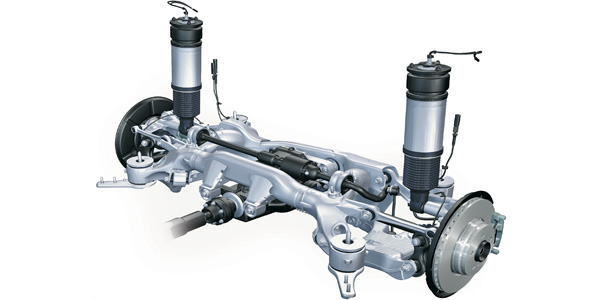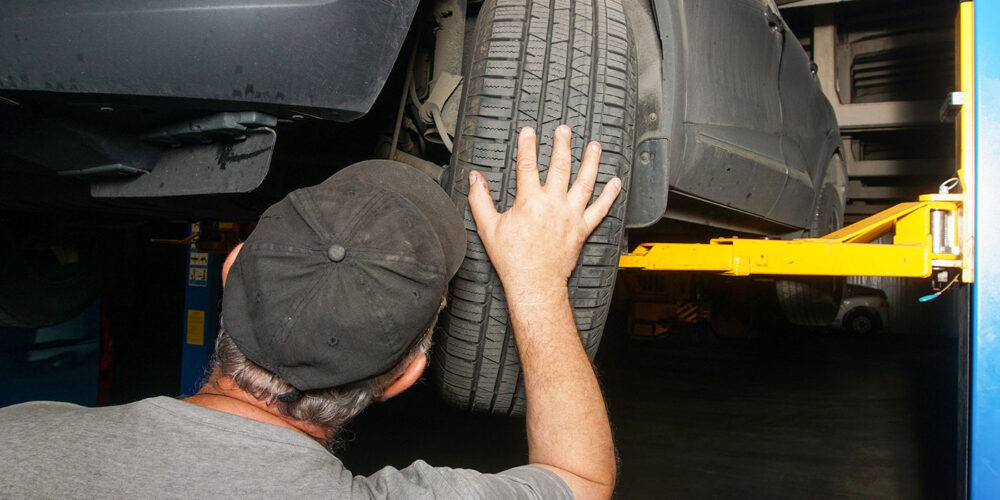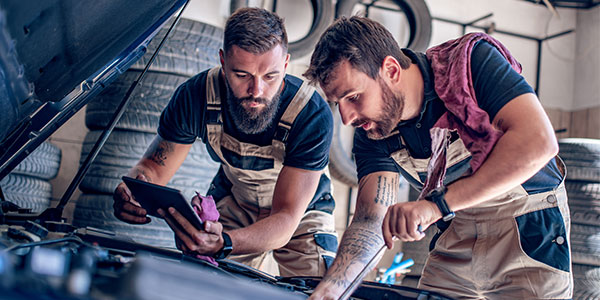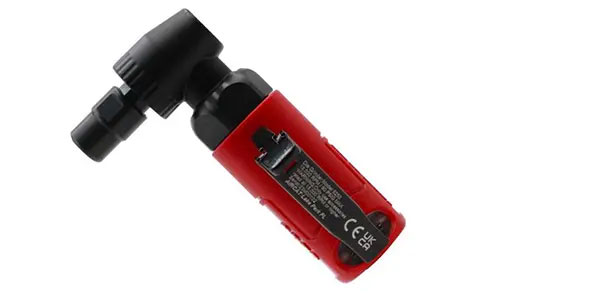Does air ride scare you? Would you prefer to sell a conversion kit rather than diagnose an air ride code or light? You are not alone. On the surface, these systems can seem complex when compared to metal springs. But, once you understand how the system senses the vehicle’s state and how the air pressure is managed, air ride diagnostics and service won’t seem so overwhelming.
An air ride system uses three basic inputs to determine if the system is operating properly. First, the pressure sensor measures pressure at the reservoir or after the compressor. Second, the ride height sensors measure the position of the wheel in the wheel well. Third, sensors that are not directly connected to the air ride system measure the ambient air temperature, vehicle speed and system voltage.
On the control side, a system can control only the compressor and solenoids to increase or exhaust pressure at the reservoir and air springs. If the rear of the vehicle is low, a solenoid opens and pressure is sent to the air springs or bladders. While this is happening, the pressure sensor is measuring system pressure at the compressor or reservoir. A code could be set if the correction causes too much of a pressure drop. If the correction takes too long, it will also set a code.
This is air ride at its most basic. The thing to remember is that the module is constantly analyzing the relationship between pressure and ride height. In the real world, the relationship and control system is more complex. Air ride systems can take into account the outside temperature, road surface and even if the vehicle is attached to a trailer.
When you are diagnosing a problem, it is critical to ask a lot of questions about the operation of the system. Then, research the reason why the problem is occurring to point you in the right diagnostic direction.
Why does the air temperature matter to an air ride system?
If air intake temperature is lower, the compressor can use denser air. In that case, the time to pressurize the reservoir should be reduced. Outside, an ambient temperature sensor or the mass airflow sensor can determine temperature. Some systems will have a thermocouple connected to the compressor. Measuring air temperature is critical because it will determine how much time it will take the compressor to fill the air springs and reservoir.
If a driver with an air ride suspension drives his vehicle home from work with an outside temperature of 32° F, and the brakes also heat the air in the bladders, the volume of air in the bladder will expand. If the driver parks the car overnight and wakes up to a 10° F morning, the air inside the bladder will have contracted and there will be less volume and pressure to support the vehicle. When he walks outside, the vehicle will be riding lower. Air temperature also impacts the reservoir. As the temperature decreases, the volume and pressure of air in the reservoir also decreases. This means there is less capacity to trim the vehicle while it is parked and when it is running.
What happens at startup?
Almost every air ride vehicle has a self-diagnostic process that occurs during startup. Depending on the vehicle, this can include checking sensor inputs, valve actuation tests and pressure checks. Some systems will open the exhaust valve to remove moisture.
The system will trim the vehicle for the specified static ride height as part of the startup diagnostic process. If the trim process uses too much pressure or compressor time, it could be the sign of a leak. This might set a code.
Where are the DTCs for the system stored?
The module that controls the air ride system typically stores the code. Advanced four-corner systems typically have a dedicated module. Some systems may use the body control module. But, it might be critical to understanding how the module communicates with other modules. Most air ride systems need information from the ambient air temperature sensor (or MAF sensor), vehicle speed and other inputs ranging from stability control to door switches.
What does it take to set a code?
What it takes to set a code depends on the vehicle. For some problems, a code might be set immediately, like in the case of a sensor or solenoid that is open or shorted. Some codes may require two or more incidents or key cycles to set a code and put the system into a safe or service mode. In some cases, the code will be cleared if the key is cycled.
On some GM Electronic Shock Control (ESC) systems, the ESC module can store DTCs as current or history codes. The system uses an ignition cycling diagnostic approach to reduce the occurrence of false or intermittent DTCs that do not affect the functionality of the system. This allows for the “fail-soft” actions to be taken whenever a malfunction condition is current, but requires the malfunction to be current for a certain number of ignition cycles before the corresponding malfunction code and message will be stored or displayed. This is why you get some customers who say they started the car again and the problem was gone.
What happens when the suspension goes into a service or workshop mode?
Rather than letting the vehicle rest on the bump stops with the compressor running non-stop, the air ride system will disable or set the suspension at a safe pressure. The vehicle will then alert the driver with an instrument panel warning. Some vehicles limit the speed of the vehicle until the problem is resolved.
Why does the compressor time out?
One of the jobs the system’s embedded logic can perform is to save the compressor from destroying itself. If a system leaks, the compressor will have to work harder to keep the vehicle at the same ride height. Excess heat can cause premature wear of the piston rings and, if the leak goes unchecked, it can cause the compressor to fail.
How does the system measure the temperature of the compressor?
Most pumps do not have a thermocouple to measure the exact temperature. The computer module controlling the pump keeps track of how long the compressor has run and how long the correction should take. If a correction to ride height takes too long, the system knows that the compressor could overheat, set a code and then disable the pump before it is damaged.
What happens when the vehicle is parked?
An air ride system performs a lot of work when the keys are not in the ignition. The system will trim the ride height to make sure the vehicle is not sitting on the ground as the air in the bladders cools and contracts. During winter, the temperature difference between when the car was parked and when it is started in the morning can cause a system to set a fault message even on a healthy system.
In addition, some systems will keep a level ride height if the vehicle is parked on an uneven surface, or if the vehicle is unlocked and a load is placed in the trunk.
Most systems have fail-safe modes that preserve the system until it can be serviced or the abnormal conditions have passed. Most units will maintain minimum pressure or height to prevent a bladder from fully compressing and the suspension from bottoming out. But, if the car sits long enough with a small leak, the reservoir will become depleted.














